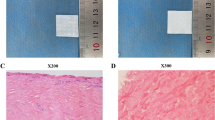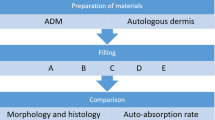Abstract
Antigenicity is the biggest obstacle of xenogeneic acellular dermal matrices (ADM) as dermal scaffold in treatment of large-area skin defect. We prepared ADM by repeated freezing and thawing and ultrasonic process, and then injected the ADM homogenate and degradation product into porcine skin to evaluate the effectiveness of the decellularized method and the antigenicity of porcine ADM. In this work, chinese miniature pigs (n = 10) were sensitized by subcutaneous injection with human ADM degradation products on days 0, 7, and 14. After 21 days, their abdominal skin was divided into five regions for intradermal injection of porcine ADM homogenate (PADM), PADM degradation products, human ADM homogenate (HADM), HADM degradation products, and physiological saline (negative control). Positive controls (n = 2) were processed with fresh human skin homogenate by the same method. The skin manifestations in related areas were observed at 24 and 48 h and then the skin was subjected to histopathological and immunohistochemical analysis. The results showed that skin erythema and hydroderma were not observed in all groups but in positive control group. The histopathological and immunohistochemical results confirmed that no inflammatory cell infiltration, irregular extracellular matrix, IL-2, and IFN-γ expression were observed in all four test groups. Our results suggest that the combination with repeated freeze–thawing and ultrasonication can be an effective method to prepare ADM, which has great potential in clinical application.




Similar content being viewed by others
References
Chen, R. N., Ho, H. O., Tsai, Y. T., & Sheu, M. T. (2004). Process development of an acellular dermal matrix (ADM) for biomedical applications. Biomaterials, 25, 2679–2686.
Callcut, R. A., Schurr, M. J., Sloan, M., & Faucher, L. D. (2006). Clinical experience with Alloderm: A one-staged composite dermal/epidermal replacement utilizing processed cadaver dermis and thin autografts. Burns, 32, 583–588.
Wainwright, D. J. (1995). Use of an acellular allograft dermal matrix (AlloDerm) in the management of full-thickness burns. Burns, 21, 243–248.
Yim, H., Cho, Y. S., Seo, C. H., et al. (2010). The use of AlloDerm on major burn patients: AlloDerm prevents post-burn joint contracture. Burns, 36, 322–328.
Feng, X., Tan, J., Pan, Y., et al. (2006). Control of hypertrophic scar from inception by using xenogenic (porcine) acellular dermal matrix (ADM) to cover deep second degree burn. Burns, 32, 293–298.
Butler, C. E., Burns, N. K., Campbell, K. T., et al. (2010). Comparison of cross-linked and non-cross-linked porcine acellular dermal matrices for ventral hernia repair. Journal of the American College of Surgeons, 211, 368–376.
Gubitosi, A., Docimo, G., Parmeggiani, D., et al. (2014). Acellular bovine pericardium dermal matrix in immediate breast reconstruction after skin sparing mastectomy. International Journal of Surgery, 12(Suppl 1), S205–S208.
Ohkuma, R., Buretta, K. J., Mohan, R., Rosson, G. D., & Rad, A. N. (2013). Initial experience with the use of foetal/neonatal bovine acellular dermal collagen matrix (SurgiMend) for tissue-expander breast reconstruction. Journal of Plastic, Reconstructive and Aesthetic Surgery, 66, 1195–1201.
Feng, X., Shen, R., Tan, J., et al. (2007). The study of inhibiting systematic inflammatory response syndrome by applying xenogenic (porcine) acellular dermal matrix on second-degree burns. Burns, 33, 477–479.
Feng, X. S., Pan, Y. G., Tan, J. J., et al. (2006). Treatment of deep partial thickness burns by a single dressing of porcine acellular dermal matrix. Zhonghua Wai Ke Za Zhi, 44, 467–470.
Chai, J. K., Liang, L. M., Yang, H. M., et al. (2007). Preparation of laser micropore porcine acellular dermal matrix for skin graft: An experimental study. Burns, 33, 719–725.
Pahari, M. P., Raman, A., Bloomenthal, A., et al. (2006). A novel approach for intestinal elongation using acellular dermal matrix: An experimental study in rats. Transplantation Proceedings, 38, 1849–1850.
Fraser, R. D., MacRae, T. P., & Miller, A. (1987). Molecular packing in type I collagen fibrils. Journal of Molecular Biology, 193, 115–125.
Fraser, R. D. B., & MacRae, T. P. (1981). Unit cell and molecular connectivity in tendon collagen. International Journal of Biological Macromolecules, 3, 193–200.
Lynn, A. K., Yannas, I. V., & Bonfield, W. (2004). Antigenicity and immunogenicity of collagen. Journal of Biomedical Materials Research Part B, Applied Biomaterials, 71, 343–354.
Breite, A. G., McCarthy, R. C., & Dwulet, F. E. (2011). Characterization and functional assessment of Clostridium histolyticum class I (C1) collagenases and the synergistic degradation of native collagen in enzyme mixtures containing class II (C2) collagenase. Transplantation Proceedings, 43, 3171–3175.
Eckhard, U., Huesgen, P. F., Brandstetter, H., & Overall, C. M. (2014). Proteomic protease specificity profiling of clostridial collagenases reveals their intrinsic nature as dedicated degraders of collagen. Journal of Proteomics, 100, 102–114.
Rnjak, J., Li, Z., Maitz, P. K., Wise, S. G., & Weiss, A. S. (2009). Primary human dermal fibroblast interactions with open weave three-dimensional scaffolds prepared from synthetic human elastin. Biomaterials, 30, 6469–6477.
Supp, D. M., & Boyce, S. T. (2005). Engineered skin substitutes: Practices and potentials. Clinics in Dermatology, 23, 403–412.
Le Moine, A., Goldman, M., & Abramowicz, D. (2002). Multiple pathways to allograft rejection. Transplantation, 73, 1373–1381.
Zhai, Y., Ghobrial, R. M., Busuttil, R. W., & Kupiec-Weglinski, J. W. (1999). Th1 and Th2 cytokines in organ transplantation: Paradigm lost? Critical Reviews in Immunology, 19, 155–172.
Walter, R. J., Matsuda, T., Reyes, H. M., Walter, J. M., & Hanumadass, M. (1998). Characterization of acellular dermal matrices (ADMs) prepared by two different methods. Burns, 24, 104–113.
Gordon, M. K., & Hahn, R. A. (2010). Collagens. Cell and Tissue Research, 339, 247–257.
Millan, O., Rafael-Valdivia, L., Torrademe, E., et al. (2013). Intracellular IFN-gamma and IL-2 expression monitoring as surrogate markers of the risk of acute rejection and personal drug response in de novo liver transplant recipients. Cytokine, 61, 556–564.
Ge, L., Zheng, S., & Wei, H. (2009). Comparison of histological structure and biocompatibility between human acellular dermal matrix (ADM) and porcine ADM. Burns, 35, 46–50.
Hardin-Young, J., Carr, R. M., Downing, G. J., Condon, K. D., & Termin, P. L. (1996). Modification of native collagen reduces antigenicity but preserves cell compatibility. Biotechnology and Bioengineering, 49, 675–682.
Krco, C. J., Pawelski, J., Harders, J., et al. (1996). Characterization of the antigenic structure of human type II collagen. The Journal of Immunology, 156, 2761–2768.
Adair-Kirk, T. L., & Senior, R. M. (2008). Fragments of extracellular matrix as mediators of inflammation. International Journal of Biochemistry & Cell Biology, 40, 1101–1110.
Debret, R., Antonicelli, F., Theill, A., et al. (2005). Elastin-derived peptides induce a T-helper type 1 polarization of human blood lymphocytes. Arteriosclerosis, Thrombosis, and Vascular Biology, 25, 1353–1358.
Morwood, S. R., & Nicholson, L. B. (2006). Modulation of the immune response by extracellular matrix proteins. Archivum Immunolgiae et Therapiae Experimentalis, 54, 367–374.
Thomas, A. H., Edelman, E. R., & Stultz, C. M. (2007). Collagen fragments modulate innate immunity. Experimental Biology and Medicine (Maywood), 232, 406–411.
Acknowledgments
We thank the faculty and staff in Jishuitan hospital Burns laboratory for their assistance to prepare ADM, Professor Gu Ming’ group of Chinese Academy of Sciences for their assistance to analyze amino acid sequence; the faculty and staff in Peking University Health Science Center Animal Lab for their assistance in animal experiment and animal management.
Author information
Authors and Affiliations
Corresponding author
Electronic supplementary material
Below is the link to the electronic supplementary material.
Rights and permissions
About this article
Cite this article
Xu, Y., Zhang, G., Chang, Y. et al. The Preparation of Acellular Dermal Matrices by Freeze–Thawing and Ultrasonication Process and the Evaluation of Its Antigenicity. Cell Biochem Biophys 73, 27–33 (2015). https://doi.org/10.1007/s12013-015-0569-9
Published:
Issue Date:
DOI: https://doi.org/10.1007/s12013-015-0569-9




